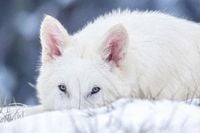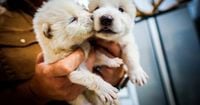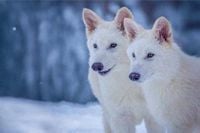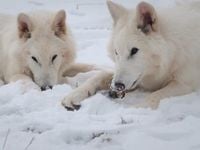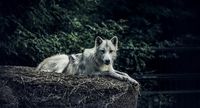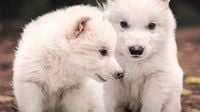On April 7, 2025, Colossal Biosciences announced a groundbreaking achievement in the field of de-extinction: the successful birth of three dire wolf puppies, marking a significant milestone in efforts to resurrect extinct species. This announcement was accompanied by a feature story in Time magazine, highlighting the innovative methods used by the company to bring these ancient canines back to life.
The puppies, named Rómulo, Remo, and Khaleesi, are part of a project that utilizes advanced genetic editing techniques to create animals that closely resemble their extinct ancestors. Rómulo and Remo were born in October 2024, while Khaleesi, the youngest, arrived in winter 2024. All three are currently thriving in a secret 2,000-acre ecological reserve, where they are closely monitored by a team of veterinarians.
Colossal's CEO, Ben Lamm, expressed pride in the team's accomplishment, stating, "This monumental milestone is the first of many examples that demonstrate our end-to-end de-extinction technology works." The company utilized DNA from a 13,000-year-old tooth and a 72,000-year-old skull to create these healthy dire wolf pups, which were bred using a combination of genetic editing and surrogate dogs.
Unlike traditional cloning methods, Colossal's scientists did not directly copy ancient DNA. Instead, they made 20 precise edits to the DNA of existing cells taken from a gray wolf, focusing on making certain genes resemble those found in dire wolves. This process involved altering approximately 0.5% of the gray wolf's genome, which equates to about 12 million base pairs that distinguish the dire wolf from its living relatives.
Despite the success, the endeavor is not without controversy. Critics argue that the dire wolf puppies, while genetically modified to exhibit dire wolf traits, cannot be considered true dire wolves due to their upbringing in captivity and the inherent differences in their genetic makeup. Beth Shapiro, Colossal's chief scientist, described the project as a form of "functional de-extinction," emphasizing that the goal is not to create exact replicas of extinct species but rather to produce viable animals that exhibit key traits.
In addition to the dire wolves, Colossal has also made strides in cloning efforts, recently announcing the birth of four red wolf puppies—Hope, Blaze, Cinder, and Ash—using a non-invasive blood cloning technique. These red wolves are among the most critically endangered canines, with only 17 to 19 individuals remaining in the wild. Colossal aims to enhance the genetic diversity of the red wolf population in North Carolina through these new births.
The process of reviving the dire wolf has not been without its challenges. Colossal's team scoured museums across the United States to obtain DNA samples from ancient fossils, which proved difficult due to the poor preservation of the DNA. Shapiro noted, "Obtaining the genome was really hard; they did not live in cold climates, so the DNA was not as well preserved."
Once the DNA was secured, the team sequenced it to identify key characteristics of the dire wolf. They then introduced genetic modifications into gray wolf cells to create embryos that were implanted into surrogate mothers, resulting in the successful birth of the three puppies. The dire wolf puppies are reported to be 20% to 25% larger than gray wolves at the same age, with expectations that they will weigh around 63 kilograms as adults.
Colossal's innovative approach to de-extinction has raised ethical questions about the manipulation of nature and the implications of introducing genetically modified organisms into ecosystems. Some scientists have expressed skepticism about the practicality and morality of such projects, arguing that the focus should be on conserving existing species rather than resurrecting those that have been lost.
Looking forward, Colossal is not stopping with the dire wolf. The company has ambitious plans to resurrect the woolly mammoth by 2028, utilizing similar genetic techniques to modify Asian elephants to exhibit mammoth-like traits such as thick fur and cold adaptation. The company has already achieved success with genetically modified mice that display woolly mammoth characteristics, paving the way for larger-scale applications in the future.
Furthermore, Colossal aims to bring back the dodo, an extinct bird since the 17th century, although challenges remain due to the complexities of avian reproductive biology. The company is currently collaborating with the government of Mauritius to develop a strategy for the dodo's potential reintroduction.
As Colossal continues to push the boundaries of genetic engineering, the implications of their work extend beyond de-extinction. They aim to apply their technologies to enhance biodiversity and improve health outcomes in existing species. Lamm stated, "If we achieve de-extinction, we will be developing technologies that can contribute to human health and conservation."
While the arrival of Rómulo, Remo, and Khaleesi represents a significant leap forward in the quest for de-extinction, it also opens the door to ongoing debates about the ethics and responsibilities of scientists in manipulating the natural world. As the company forges ahead, the world watches closely, eager to see what the future holds for both extinct and endangered species alike.
